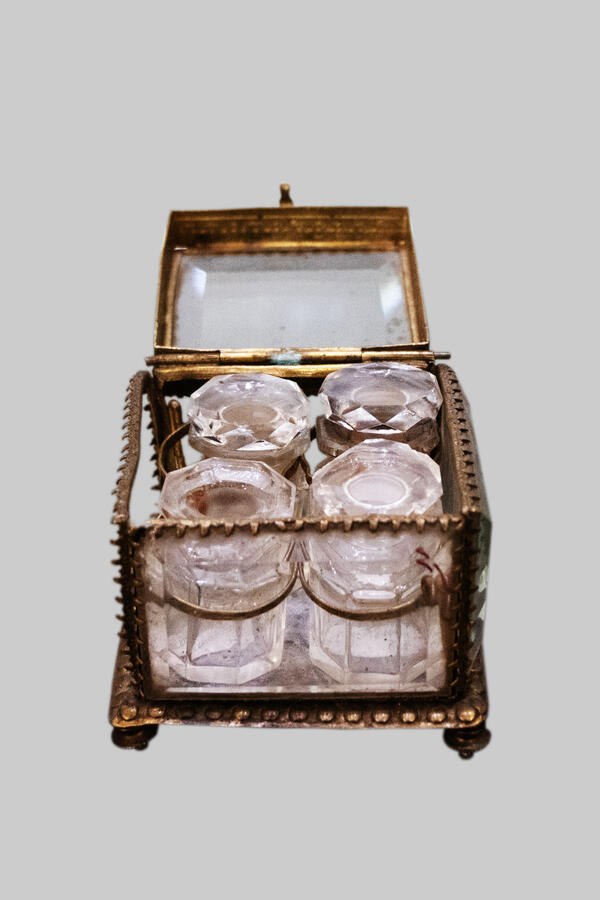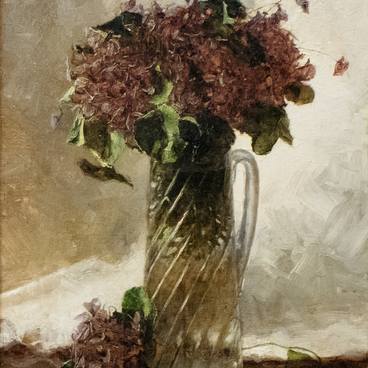A set of four bottles in a cube-shaped glass box. The box is enclosed in a metal edging, part of which are round legs.
In the 16th–18th centuries, graceful perfume bottles were status items, akin to jewelry and fashionable clothes. Only the nobility could afford such ‘toys.’ The perfume itself was also a product not available to the general public. In the 18th century, it was impossible to imagine a servant or a factory worker wearing perfume. The situation changed fundamentally only in the late 1800s. By this time, even the simplest of maids could keep a bottle of floral perfume on her nightstand, sometimes more than one.
It is believed that the first perfume compounds were created in ancient Egypt. It is possible that the Egyptians adopted the tradition of perfume making from Mesopotamia. One of the cuneiform tablets from the second millennium BC mentions a female perfumer named Tapputi.
In Russia, producers of cosmetics and personal care products began to emerge only in late 19th century. Before that, all perfumes were imported from Western Europe. Since eau de toilette, colognes, and incense were made using plants and herbs, the bottles were initially sold in pharmacies.
When specialized perfume shops emerged, they started offering perfume refills. Of course, they also sold bottles of perfume, but it was considered wasteful to buy a new bottle every time. So people usually either used one bottle, or bought a bottle separately.
Glassmakers quickly saw the profit potential and started creating special gift sets perfume storage. Such sets were often a work of art in themselves and adorned dressing tables of wealthy ladies.
At the turn of this century, the focus on bottle design became even more pronounced. Famous artists took years to design some of them. The perfume refilling business has gradually died out, and the scent of a perfume is now inextricably linked to its package design: both elements are copyrighted and are a source of pride for manufacturers.
In the 16th–18th centuries, graceful perfume bottles were status items, akin to jewelry and fashionable clothes. Only the nobility could afford such ‘toys.’ The perfume itself was also a product not available to the general public. In the 18th century, it was impossible to imagine a servant or a factory worker wearing perfume. The situation changed fundamentally only in the late 1800s. By this time, even the simplest of maids could keep a bottle of floral perfume on her nightstand, sometimes more than one.
It is believed that the first perfume compounds were created in ancient Egypt. It is possible that the Egyptians adopted the tradition of perfume making from Mesopotamia. One of the cuneiform tablets from the second millennium BC mentions a female perfumer named Tapputi.
In Russia, producers of cosmetics and personal care products began to emerge only in late 19th century. Before that, all perfumes were imported from Western Europe. Since eau de toilette, colognes, and incense were made using plants and herbs, the bottles were initially sold in pharmacies.
When specialized perfume shops emerged, they started offering perfume refills. Of course, they also sold bottles of perfume, but it was considered wasteful to buy a new bottle every time. So people usually either used one bottle, or bought a bottle separately.
Glassmakers quickly saw the profit potential and started creating special gift sets perfume storage. Such sets were often a work of art in themselves and adorned dressing tables of wealthy ladies.
At the turn of this century, the focus on bottle design became even more pronounced. Famous artists took years to design some of them. The perfume refilling business has gradually died out, and the scent of a perfume is now inextricably linked to its package design: both elements are copyrighted and are a source of pride for manufacturers.



